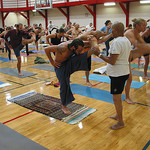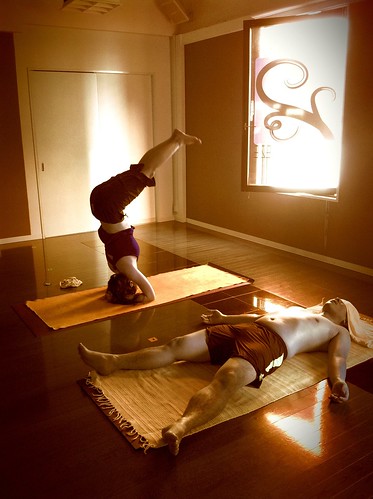the search for a new yoga teacher/studio


It took me about a month of heavy searching to find my yoga teacher. How you do it depends largely on what you look for. Instead of making a list for you: location, teacher’s experience, price, style, schedule…which I touched on in the last few posts. I will tell you my story, and you can suss out how to go about it from there in a way that works for you.
I knew I wanted a Mysore-style ashtanga shala (school), so I asked my ashtanga friends for recommendations. I read about the teachers, schedules, locations, and prices online, and I had an inking about where I’d end up. In the weeks I researched this, I hit a few studios in my neighborhood I’d never tried. They weren’t ashtanga schools, but the convenience of a studio but few blocks from home was too ideal not to try, even if I knew I wouldn’t end up there.
The first, Yogamaya, is a gorgeous studio in Chelsea. I’d taken classes from the founders years back at Laughing Lotus, a vinyasa studio also in Chelsea, and the yoga is the same. I tried a $28/week newcomers’ unlimited pass and went to three classes. Two, taught by Bryn, were very good. I’m just not into their wild choreographic sequencing. I suppose that it’s good for people who feel bored with traditional yoga sequences, but being bored is part of the practice. I find it impossible to go into my body when I’m waiting to hear what unknown, awkward transition will come next. I also don’t like spending 10 minutes on one side of the body standing, sitting, arm balancing, inverting, and then getting back up to do it all over again on the other. This is not how it’s meant to be. In traditional styles like ashtanga and Iyengar, we do the right side and then the left for each and every pose before we move on to the next. I will not bore you with the art and reasoning of yoga sequencing and the energetic properties of different poses. But many years ago, I noticed that classes with unpredictable posturing make me feel high strung. Sometimes good, like I had a nice work out, but not balanced and in my body, like more traditional styles of yoga do. Plus the work-out effect.
The third class I took there was with a very young teacher. It featured the most questionable sun salutation sequencing I’ve ever encountered. From standing forward bend, we sat down into a squat, and then jumped back. At the end, we jumped forward into a squat, then came up to forward bend. This is hell on the knees. In a squat, the toes are pointing out, in the direction of the knees. In the other poses they are straight forward. The was no safe way to transition this sequence, and the fact that it was totally awkward and unpleasant was not even addressed by the teacher. Ouch. It was enough to keep me from trying other classes there during my paid week. That said, it is a beautiful studio and I’m sure they have some amazing teachers. If you like funky sequencing, chanting to a harmonium, heavy appropriation of Indian culture, and inspirational, personal talks by your teacher at the start of class, Yogamaya (or Laughing Lotus) might be just your thing.
Because I am frequently asked about both Bikram and Yoga to the People (now defunct. Yes, another sex scandal), I also went to the Hot YTTP on W26th Street. Yes, I took a hot yoga class. As expected, it was hot, and because I like to be warm, I enjoyed it more or less. I’m not into locking out the joints, which is a hot yoga specialty. In all the types of yoga I’ve done, they all pretty much agree that locking out the joints is not a good thing. Further, there’s a lot of pushing to go further, and who can really feel her limits at 4pm in a 100+ degree room? The muscles are like rubber. It’s certainly not a not-quite-heated, 6am ashtanga shala, where coaxing the muscles to open of their own accord is the name of the game. There are also some poses that aren’t great for the masses, like supta virasana and a weird whipping up to paschimottanasana from lying flat on the back, which is done numerous times. I’m partial to the jump backs and jump throughs of ashtanga to strengthen the mid-region. But I’m obviously biased. The studio was fine. I didn’t find it any less posh than the Bikram studio I tried for a week years back in San Francisco. The teacher was nice enough. I don’t remember his name, and that’s likely because YTTP don’t emphasize teachers or even put their names on the schedules, I assume to avoid the cult of personality that can form around teachers. I get that, though I don’t agree with it. I want know to whom I’m subjecting myself for an hour and a half.
Further, In early December, Bikram and YTTP came to a settlement (Bikram sued them for using his copyrighted sequence of poses) and YTTP will stop teaching that sequence as of Feb 15, 2013. “So what?” I say. It’s hardly a brilliant sequence. Change it up a bit, make some improvements, and maybe I drop by on a moon day or two.
So, hopefully it’s evident that this is a process of trial and error. Because I’m not partial to these studios doesn’t mean you might not be. I went to Laughing Lotus for a year or two when I was moving from integral hatha to vinyasa. I enjoyed the work out and it’s what I wanted at the time. Then I found the amazing, must-be-experienced Iyengar teacher Genny Kapular. She instilled in me a love for mindful sequencing and I’ve had a hard time with overly creative sequencing ever since.
The next post will be about the ashtanga teachers I tried, their studios, and those I didn’t get to because I found what I was looking for first.